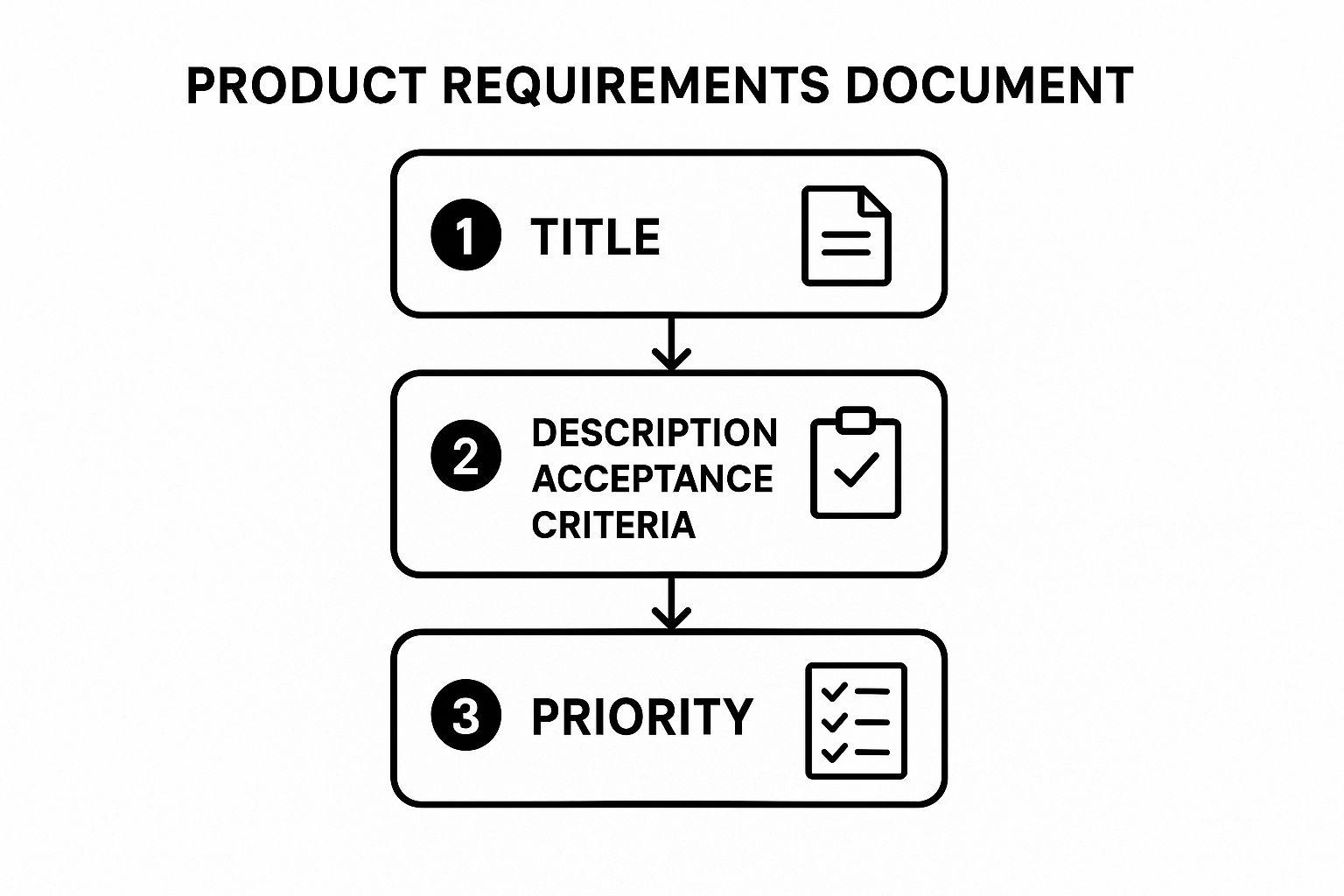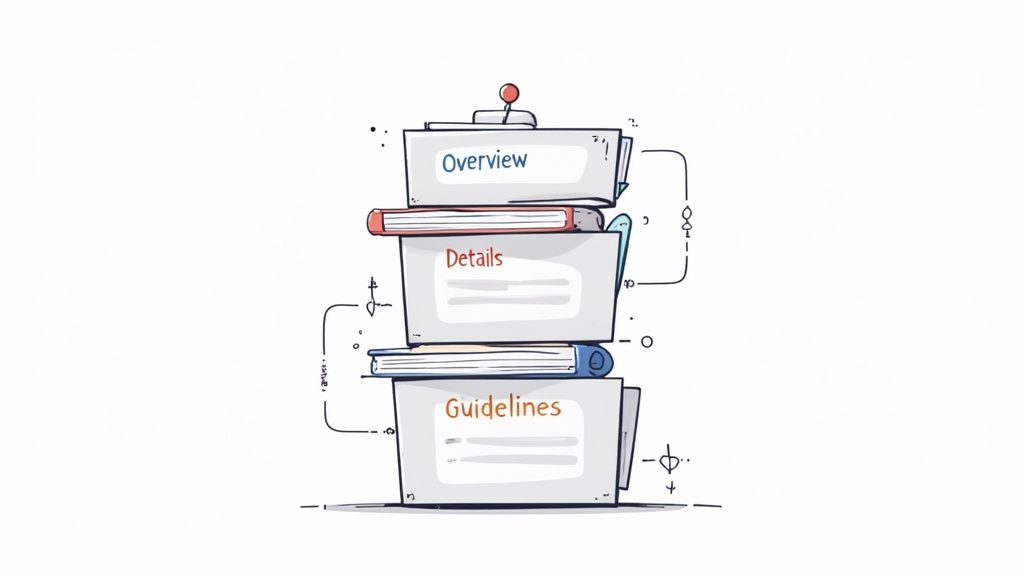Poor requirements are the silent killer of great products. Research from the Project Management Institute reveals a sobering statistic: nearly 47% of unsuccessful projects fail due to poor requirements management. This isn’t just a minor hiccup; it’s a multi-billion dollar problem leading to wasted engineering hours, blown deadlines, and products that completely miss the mark.
When you write product requirements, you’re not just filling out a template. You are creating the single source of truth that translates a vision into an actionable blueprint. Getting this right from the start is the critical factor that separates successful product launches from those that descend into chaos.
Why Clear Product Requirements Are Your Secret Weapon
Let’s be honest, staring at a blank Product Requirements Document (or PRD) can be daunting. But crafting a solid one is less about paperwork and more about building a shared understanding across your teams. Without it, you invite miscommunication and rework—where engineers build one thing, designers mock up another, and stakeholders expect something else entirely.
Think of a well-written PRD as the central nervous system for your project. It’s the handshake between product, design, and engineering, ensuring everyone is aligned on the objectives. This document isn’t just a laundry list of features; it’s a strategic guide that answers the most critical questions:
- What problem are we actually solving? This keeps everyone focused on delivering real value to the user, not just shipping code.
- Who is this for? Nailing down the user persona ensures the solution is genuinely useful for the people who will be using it.
- How do we know if we’ve succeeded? Setting clear, measurable metrics from the get-go eliminates any guesswork about what a “win” looks like.
The High Cost of Fuzzy Requirements
When requirements are vague, people are left to fill in the blanks with their own assumptions. An engineer’s idea of a feature might be completely different from what the designer mocked up or what a key stakeholder was expecting. This is a recipe for disaster, leading to endless clarification meetings, wasted development time, and a final product that doesn’t really satisfy anyone.
The numbers don’t lie. A report from the Project Management Institute found that poor requirements gathering is a major contributor to project failure—we’re talking nearly 47% of unsuccessful projects. This really drives home how crucial good documentation is. It’s the guidebook that explains what needs to be built, why it matters, and how to get it done. You can dig deeper into these findings and what they mean for your projects over on meegle.com .
Before we move on, let’s quickly break down the core pieces that make up a strong PRD. Having a clear structure helps ensure you don’t miss anything important.
Key Components of an Effective Product Requirements Document
| Component | Purpose |
|---|---|
| Introduction & Purpose | Briefly explain what the project is and what problem it solves. |
| Goals & Objectives | State the specific, measurable business and user goals. |
| User Personas & Stories | Describe the target user and their journey. |
| Features & Functionality | Detail what the product will do, often with user stories. |
| Technical Requirements | Outline any technical constraints or non-functional needs. |
| Design & UX Mockups | Include links to wireframes or high-fidelity designs. |
| Success Metrics | Define the key performance indicators (KPIs) to track success. |
| Assumptions & Risks | List any assumptions made and potential risks to the project. |
This table is just a starting point, but it covers the essentials that align everyone from stakeholders to engineers.
A PRD is more than a to-do list; it’s a strategic tool. It forces you to validate your assumptions and articulate your vision with precision, transforming a vague idea into an actionable blueprint for your team.
Ultimately, learning how to write great product requirements is about managing risk. A clear, comprehensive PRD is your best defense against the usual suspects of software development gone wrong: scope creep, miscommunication, and building something nobody actually wants. It’s that upfront work that saves you countless headaches down the line.
Laying the Groundwork Before You Write

It’s tempting to dive right into writing a product requirements document (PRD). But if you start typing before you’ve done your homework, you’re basically just building a list of assumptions. And we all know how that usually ends: you build features nobody actually needs.
The best product requirements aren’t written from scratch; they’re discovered. This discovery phase is your foundation. Skimp on it, and you’ll end up with a wobbly product that’s bound to fall over. Think of it as setting sail without a map—sure, you’re moving, but you’re probably not heading in the right direction.
Talk to Your Stakeholders to Find the Real Goal
First things first, you need to talk to people. And I don’t mean just collecting a feature wish list. When you sit down with stakeholders, your real job is to dig for the why behind their requests.
If a sales leader tells you, “We need a new dashboard,” don’t just nod and add it to the list. Ask why. Is it because they can’t track their team’s performance? Or maybe clients are asking for reports they can’t generate? Those are two completely different problems. Getting this clarity is everything—in fact, a study found that clear alignment on business goals is one of the biggest drivers of project success.
To get to the heart of the matter, try asking open-ended questions like:
- What problem are you really hoping this project will solve?
- If we fast-forward six months, what does success look like for your team?
- What’s the biggest risk you see if we get this wrong?
This kind of questioning pulls the conversation away from pre-baked solutions and back to the problems, which is where all the valuable insights are hiding.
Scope Out the Market and Your Competition
Your product doesn’t exist in a bubble. A solid analysis of the market and your competitors helps you understand the world your product will live in and, more importantly, find your unique place in it.
Pay attention to what your competitors do well, but look even closer at where they fall short. Those gaps are where your opportunities lie. For instance, imagine you’re building a new project management tool. If you notice all the big players are focused on complex enterprise features, you might spot an opening for a simpler, more intuitive tool designed specifically for small teams.
This kind of insight is gold. It directly shapes what you should prioritize.
A huge part of learning how to write product requirements is knowing what not to build. Competitive analysis gives you the hard evidence you need to confidently say “no” to ideas that don’t fit your strategy, saving everyone a ton of time and resources.
Figure Out Who You’re Building For with User Personas
At the end of the day, every requirement should solve a real problem for a real person. This is where user personas come in. Personas are essentially profiles of your ideal users, built from real research, that represent the different kinds of people who will use your product.
Let’s say you’re working on a mobile banking app. You might have a couple of distinct user types:
- “Savvy Investor Sarah”: A 30-year-old professional who wants advanced trading features and live market data at her fingertips.
- “Budgeting Ben”: A 22-year-old student who just needs simple tools to track his spending and maybe tuck a little money away.
Clearly, Sarah and Ben have very different needs. A requirement like “display stock tickers on the home screen” would be a game-changer for Sarah but totally useless for Ben. By creating and validating these personas through user interviews and surveys, you make sure every feature you spec out serves a specific, well-understood audience. It’s how you build a product people actually want.
Structuring Your PRD for Total Clarity
A sloppy, confusing PRD almost guarantees a sloppy, confusing product. It’s that simple. If you want to avoid endless debates, missed deadlines, and a final product that just doesn’t hit the mark, you need a rock-solid structure for your Product Requirements Document.
Think of a well-organized PRD as the project’s single source of truth. It’s where everything lives, from the big-picture goals right down to the nitty-gritty details of each feature. The best ones always include concrete objectives—like boosting user retention by 10%—and detailed user stories that paint a clear picture of who you’re building for. You can find more great insights on building a robust PRD and aligning your team over at aha.io).
This diagram breaks down what a good requirement actually looks like. It’s not just a title; it’s a complete package with a description, acceptance criteria, and a clear priority.

The key takeaway here is that every requirement needs to be actionable and testable. That’s what turns a vague idea into a real task your team can actually build.
From Business Goals to Success Metrics
Your PRD has to connect the dots between the work being done and what the business hopes to achieve. This isn’t just about listing features; it’s about explaining why they matter. Defining specific, measurable success metrics isn’t optional—it’s essential.
A goal like “improve the user experience” is completely useless because it’s impossible to measure. Instead, you need to translate that into something tangible. For instance, if you’re redesigning a checkout process, a clear success metric would be: “Reduce cart abandonment rate from 40% to 30% within Q3.” This gives your team a finish line to cross and makes it easy to know if you’ve succeeded.
Your metrics are your definition of “done.” If you can’t measure it, you can’t know if you succeeded. Tie every major feature or initiative back to a key performance indicator (KPI).
The Power of Compelling User Stories
Once you’ve set your high-level goals, it’s time to bring them down to earth from the user’s point of view. This is where user stories come in. They are a deceptively simple way to frame requirements around the value a user gets, not just the technical work involved.
The classic user story format is straightforward: As a [type of user], I want to [perform some action] so that I can [achieve some goal]. This structure forces you to think about who you’re building for and what benefit you’re delivering.
- Weak Requirement: “Implement a bulk user invite feature.”
- Strong User Story: “As a team administrator, I want to bulk-invite new users via CSV upload so that I can onboard my entire 50-person team in minutes instead of hours.”
See the difference? The second example gives the team critical context. It immediately tells them who they’re building for and the specific, painful problem they’re solving. That context drives much better design and development decisions.
Don’t Forget Non-Functional Requirements
It’s so easy to get laser-focused on the features you can see and click. But the requirements that work behind the scenes are every bit as important. These are your non-functional requirements (NFRs), and they define the quality and stability of your product. Ignoring them is a rookie mistake that leads to slow, insecure, or unreliable software.
Here are the key NFRs you absolutely must define:
- Performance: How fast should it be? Get specific. For example, “The user dashboard must load in under 2 seconds, even when a user has 1,000 active projects.”
- Security: What are the security standards? This might include requirements like, “All user data must be encrypted at rest and in transit using AES-256 encryption.”
- Scalability: How will the system handle growth? An example could be, “The application must support 10,000 concurrent users without any drop in performance.”
- Reliability: What’s the acceptable uptime? A common target is “99.9% uptime,” which means no more than 8.77 hours of downtime per year.
Defining these NFRs upfront is a critical part of writing a PRD that leads to a professional-grade product. They give your engineering team clear guardrails and a quality bar to build against.
Writing Requirements Your Developers Will Understand

Even the most brilliant product idea can fall apart in translation. I’ve seen it happen countless times—a massive gap opens up between what the business side imagines and what the engineering team ends up building. If you want to write product requirements that actually work, your number one job is to bridge that gap.
The enemy here is ambiguity. When requirements are fuzzy, developers have no choice but to fill in the blanks themselves. Their assumptions rarely match your original vision, which almost always leads to painful rework, blown deadlines, and a product that just misses the mark.
Define Concrete Acceptance Criteria
So, how do you eliminate that ambiguity? The most effective way I’ve found is to define rock-solid acceptance criteria for every single feature or user story. Think of these as a simple checklist: for a feature to be marked “done,” it must pass every item on this list. This process turns an abstract concept into a concrete, testable outcome.
It’s the difference between giving a home builder a rough sketch on a napkin versus a detailed architectural blueprint. One leaves far too much to chance; the other provides a clear, shared path forward.
Let’s look at a common example: a user profile feature.
- Vague Requirement: “Users should be able to create a profile.”
- Clear Acceptance Criteria:
- Given a new user is on the sign-up page,
- When they fill in their first name, last name, email, and password,
- And click the “Create Account” button,
- Then the system must create a new user record in the database.
- And the user should be immediately redirected to their dashboard.
- And their full name must appear in the top navigation bar.
This “Given/When/Then” structure is a lifesaver. It’s a simple syntax that clearly lays out the context, the user’s action, and the expected result. It gives developers a precise target to build toward and makes life easier for QA testers, too.
Visualize Requirements with Wireframes and Mockups
Words alone can only do so much. Sometimes, a simple visual is all it takes to prevent a dozen clarification emails. Wireframes and mockups aren’t just for designers; they are indispensable communication tools for product managers. They create a universal language that the entire team—from marketing to engineering—can instantly grasp.
Just drop a link to a Figma or Sketch file directly into your requirements document. This tiny action gives developers an immediate visual anchor, preventing massive misunderstandings about layout, user flow, or how an interaction should feel.
An engineer once told me, “Don’t just tell me what it should do, show me what it should look like.” That stuck with me. A simple wireframe clarifies more than a thousand words of text ever could.
Document Constraints and Edge Cases
Finally, a truly great requirement anticipates the “what-ifs.” What happens when things go wrong? Are there technical limitations we have to work around? Thinking through these questions upfront saves an unbelievable amount of time and headaches down the road.
Don’t forget to cover these areas:
- Dependencies: Does this feature depend on a third-party API? If that API goes down, what’s the fallback plan? Document it clearly.
- Technical Constraints: Are there performance goals? Be specific. For instance, “The search results page must load in under 500ms.”
- Edge Cases: What happens when a user does something unexpected? For example, “If a user tries to upload a file larger than 10MB, the system must display an error message: ‘File size exceeds the 10MB limit.’”
When you document these details, you’re not just writing requirements; you’re empowering your engineering team. You’re showing them you’ve thought through the complexities, which builds trust and enables them to build the right thing, the right way, the first time.
How to Handle Requirements in Tricky Industries
Crafting product requirements for a social media app is one thing. Doing it for a fintech platform or a medical device? That’s a whole different ballgame.
When you’re working in highly regulated or client-facing environments, your Product Requirements Document (PRD) carries a lot more weight. It stops being just an internal guide for developers and designers and becomes a crucial source of truth for your legal, compliance, and support teams.
This is especially true in sectors like healthcare and finance, where security and regulatory rules aren’t just suggestions—they’re ironclad laws. For these kinds of products, the PRD has to be the definitive reference for how you’re meeting those strict standards. If you want to see how top-tier teams manage this, it’s worth digging into how they operate in these complex fields.
The secret? Bring these specialized teams into the loop from the very beginning. Waiting until the end to get a “compliance check” is a surefire way to cause expensive rework and massive launch delays.
Weaving In a Web of Rules and Security
If you’re building for a regulated industry, you can’t just sprinkle some “compliance” on top at the end. It has to be baked into the DNA of your product from the first line of your PRD. This means you have to go way beyond standard user stories and write requirements that tackle these specialized needs head-on.
Here’s a practical way to think about it:
- Data Privacy: Don’t just write, “The product must be GDPR compliant.” That’s not helpful. Instead, get granular: “The user must have a clear option to request full data deletion, and the system must permanently execute this request within 30 days.”
- Security Protocols: A vague requirement like “the system must be secure” is completely useless. Be specific and actionable: “All user authentication endpoints must be protected against brute-force attacks by implementing rate limiting of 5 failed attempts per minute.”
- Accessibility Standards: If your product has to meet WCAG 2.1 AA standards , build that into your requirements. For example: “All interactive form elements must have a visible focus indicator with a contrast ratio of at least 3:1 against the background.”
This level of detail gives your engineering team clear, testable goals. It leaves absolutely no room for interpretation on the things that could get your company into serious trouble.
In a regulated space, your PRD is as much a legal and compliance document as it is a product guide. Treat it with that level of rigor. Involve your experts early, document every single rule, and make adherence a core part of your acceptance criteria.
How to Manage Scope When Clients Are Involved
Working at an agency or a software consultancy? Your PRD has another critical job: managing client expectations and stopping scope creep in its tracks. Think of the PRD as your project’s contract—it defines exactly what you’re going to deliver.
Without a rock-solid PRD, you’re wide open to those dreaded “just one more thing” requests that can completely derail a project and tank your profit margins.
When you’re writing requirements for a client, be painfully specific about what’s included. And, just as importantly, what’s not included. Use the PRD to draw a firm line in the sand. When a client inevitably asks for a new feature later on, you can simply point back to the signed-off document. This turns a potential argument about what was “implied” into a productive conversation about a change order. It’s a simple practice that protects your team, your timeline, and your budget.
A Few Common Questions About Product Requirements
Even the most seasoned product managers run into questions when drafting product requirements. It’s just part of the process. Let’s tackle a few of the most common ones I hear, so you can move forward with a bit more clarity and keep everyone on the same page.
How Much Detail Is Too Much?
This is the classic balancing act. Your PRD needs enough detail to kill any ambiguity, but not so much that it stifles the creativity of your team. I always tell people to focus on the what (what problem are we solving for the user?) and the why (why does this matter to the business?). Leave the how—the technical implementation—to your brilliant designers and engineers.
To get the right level of clarity, I make sure to include:
- User Stories: Always frame the work from the customer’s point of view.
- Acceptance Criteria: Spell out exactly what “done” means in clear, testable terms.
- Non-Functional Requirements: Don’t forget performance, security, and scalability. These can make or break a feature.
The big takeaway? Give your team the problem, the context, and the constraints. Then, get out of their way and let them work their magic to find the best solution.
Who’s Actually in Charge of Writing This Thing?
Officially, the product manager owns and writes the Product Requirements Document. That’s almost always the case. But—and this is a big but—writing a PRD should never happen in a silo.
A PRD written in isolation is just a wish list. A PRD created with input from engineering, design, sales, and support becomes a shared commitment. This collaborative approach is vital, as research shows that poor team communication is a leading cause of project failure.
I learned early on to bring in my key stakeholders from the very beginning. Getting their input and perspective ensures we’re all aligned from day one, which saves a world of headaches later.
Is It Okay for the PRD to Change After It’s “Done”?
Yes, and it absolutely should. Think of your PRD as a living document, not something carved in stone. This is non-negotiable, especially if you’re working in an Agile environment where learning and adapting are baked into the workflow.
The PRD sets the initial course, but you’re going to learn things during development, user testing, and from customer feedback. The document needs to reflect that new knowledge. The trick is to have a solid process for managing those changes and communicating them clearly to everyone involved. That’s how you avoid scope creep and confusion.
Automating PRD Generation with AI
While writing PRDs manually is essential knowledge, modern tools can help streamline the process. Watch how AI coding agents can assist with automated PRD generation when given the right context about your project:
See how context-aware planning sessions work, how to analyze your codebase for patterns, and how to generate comprehensive technical specs and task documents that align with your requirements.
Ready to stop hallucinations and build features faster? Context Engineering connects to your IDE and provides precise, real-time project context to AI agents, turning your product requirements into production-ready code. Drastically reduce wasted tokens and streamline your entire development workflow. Get started in two minutes .
